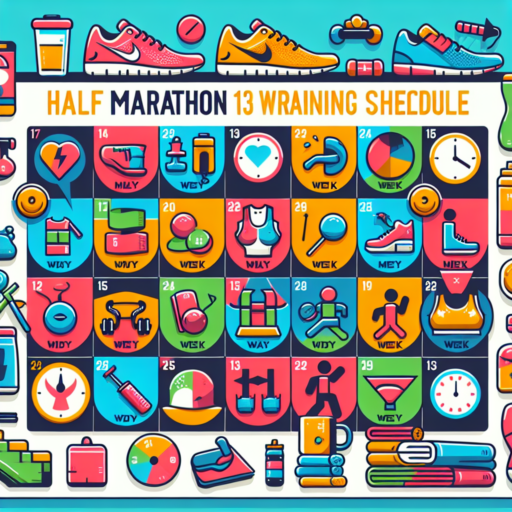Introduction to Your Half Marathon 13-Week Training Schedule
Embarking on a journey to complete a half marathon is an exciting challenge that requires dedication, perseverance, and a solid training schedule. A 13-week training plan is an ideal period for beginners and intermediate runners alike to prepare their bodies and minds for the 13.1-mile race. This length of time allows for a progressive build-up of distance and intensity, minimizing the risk of injury while maximizing endurance and performance.
The beauty of a 13-week training schedule lies in its balance between gradual progression and ample recovery time. This period is structured to help you gradually increase your running mileage, incorporate strength and flexibility training, and include essential rest days. Whether you’re a first-timer aiming to cross the finish line or a seasoned runner looking to improve your time, understanding the key components of this tailored training plan is crucial for success.
Throughout this training guide, we will provide insights on how to navigate through the weeks leading up to race day. From establishing a solid foundation in the initial weeks to fine-tuning your performance as the race approaches, each phase of your training schedule is designed with a specific purpose in mind. Adhering to this well-constructed plan will not only prepare you physically but also boost your confidence, setting the stage for an exhilarating and rewarding half marathon experience.
Weeks 1-4: Building a Solid Foundation for Your Half Marathon Training
The initial four weeks of your half marathon training are crucial in building a strong, resilient foundation that will support you through the rigors of upcoming workouts and ultimately, the race itself. This initial phase is designed to establish a base level of fitness, integrate running into your routine, and minimize the risk of injury as your body adapts to the increased physical demand.
Establishing a Consistent Running Routine
Consistency is key during the first few weeks. It’s not about how fast or far you can run; rather, it’s about gradually increasing your mileage and building a habit. Start with three to four runs per week, ensuring at least one day of rest in between. This helps your muscles recover and grow stronger. Incorporating rest days is as crucial as the running days to prevent overuse injuries and to allow for optimal adaptation and recovery.
Focus on Cross-Training and Strength Building
In addition to running, cross-training activities—such as cycling, swimming, or yoga—play an integral role in building your aerobic base without overloading your muscles and joints. Combined with two or three short sessions of targeted strength training exercises, these activities contribute to your overall endurance, stability, and running efficiency. Emphasizing core, glute, and leg strength can significantly enhance your running performance and mitigate the risk of common running injuries.
As you move through these initial weeks, listen to your body and adjust your training accordingly. Incorporating flexibility in your training plan is essential, as it allows you to manage and adapt to fatigue, soreness, or unforeseen challenges without compromising the foundational goal of your training. Remember, the aim of this phase is not to push yourself to the limits but to prepare your body and mind for the journey ahead in a sustainable and injury-free manner.
Weeks 5-8: Increasing Distance and Endurance
As you venture into weeks 5 to 8 of your training, it’s time to shift the focus towards increasing the distance and stamina of your runs. This stage is crucial for building the endurance necessary to meet and exceed your running goals. Instead of adding mass mileage abruptly, which can lead to injuries, there’s a smarter approach to gradually enhance your mileage.
During these weeks, extending your longest run of the week is a key strategy. Adding approximately 10% more distance each week is a widely accepted practice. This increment is enough to push your boundaries while significantly minimizing the risk of injuries. Besides extending the length of your runs, incorporating variety in your training plays an essential role. Including a mix of tempo runs, intervals, and easy days helps in building endurance more effectively than merely increasing volume alone.
Listen to Your Body
Moreover, listening to your body during this period cannot be overstated. It’s imperative to pay close attention to any signs of overexertion or discomfort, as these could be indicators of potential injuries. Implementing rest days or opting for cross-training activities such as cycling or swimming can provide your body with the essential recovery it needs. This balanced approach not only aids in increasing distance and endurance but also ensures a holistic development of your physical fitness.
Weeks 9-12: Introducing Intensity and Tapering Techniques
As we progress into weeks 9-12 of your training plan, a pivotal shift occurs towards integrating intensity and tapering techniques into your regimen. This phase is crucial for those aiming to peak their performance for an upcoming event or simply looking to elevate their physical conditioning to a new level. Intensity workouts are designed not just to push your limits but to break through them, whereas tapering ensures your body is well-rested and at its pinnacle of strength when it matters most.
Introducing intensity into your workouts means incorporating exercises that are higher in effort but shorter in duration compared to those in the initial stages of your training. This might include intervals, hill repeats, or tempo runs, depending on your specific goals and sport. Such activities enhance your muscular endurance, cardiovascular efficiency, and speed, setting the foundation for a strong finish in your training cycle. It’s a period marked by challenging sessions that test your mental and physical grit, fostering significant improvements in performance.
Tapering techniques, on the other hand, involve a deliberate reduction in training volume and intensity as your event approaches. This strategy allows your body to recover from the cumulative fatigue of the preceding weeks, ensuring you’re well-rested and primed for performance. During this tapering phase, maintaining a focus on nutrition, hydration, and recovery practices becomes even more paramount. It’s a fine balance between maintaining fitness levels and reducing fatigue, with the ultimate aim of achieving peak performance when it counts.
Week 13: Final Preparations and Race Week Strategies
As we dive into Week 13, the air is thick with anticipation and meticulous planning. This crucial time before your race demands a focused approach to ensure that both mind and body are in peak condition. Final preparations are not only about tapering your physical efforts but also about fine-tuning your mental readiness and logistical planning.
Physical Readiness: Tapering Your Training
In the final lead-up to race day, it’s essential to adjust your training regimen. Embrace the tapering process by gradually reducing the volume and intensity of your workouts. This strategic slowdown allows your body to recover, repair, and ultimately reach its peak performance potential. Prioritize rest, as well as light, invigorating activities that keep muscles limber without inducing fatigue. Remember, at this stage, it’s more about maintaining fitness than pushing limits.
Mental Preparation: Visualizing Success
Mental prowess is equally as crucial as physical preparedness when approaching the starting line. Spend time visualizing the course, imagining yourself overcoming challenges, and crossing the finish line. This mental rehearsal enhances focus and can help alleviate pre-race jitters. Establishing a calm, positive mindset is your secret weapon in unleashing true potential during the event.
Navigating the final week before a race also involves meticulous attention to logistics – from ensuring your race kit is ready and checking weather forecasts to planning your meals and hydration strategy. This period is your final opportunity to address any lingering concerns and set the stage for a successful, enjoyable race experience. By taking a comprehensive approach to your final preparations, you are laying the groundwork for not just finishing the race but excelling beyond your expectations.
No se han encontrado productos.
Nutrition Tips for Half Marathon Success
Preparing adequately for a half marathon not only involves rigorous training but also paying close attention to your nutrition. The right dietary strategies can significantly enhance your performance, energy levels, and recovery. Below are essential nutrition tips tailored for half marathon success.
Carb Loading with a Twist
While carb loading is a popular strategy among runners, it’s crucial to approach it with a twist for half marathons. Instead of aggressively loading carbs just the day before, gradually increase your carbohydrate intake in the week leading up to the race. This method helps maximize your muscle glycogen stores without the risk of feeling bloated or sluggish on race day. Opt for complex carbohydrates like whole grains, fruits, and vegetables, which provide a steady energy release.
Hydration Is Key
Hydration affects not just your performance but also your overall health during the race. Begin hydrating days before the event, aiming to drink at least half your body weight in ounces of water each day, adjusting for heat and sweat loss. Incorporating electrolyte-enhanced beverages can also help maintain the balance of minerals lost through sweat. Keeping well-hydrated ensures optimal physical function and can prevent cramps and fatigue.
Maintaining a balanced diet rich in proteins, healthy fats, and antioxidants in the weeks leading up to the race is equally important. Proteins support muscle repair and recovery, fats provide an energy reserve for longer distances, and antioxidants help combat the oxidative stress of intense training. Remember, your nutrition plan should be personalized to fit your body’s needs and training regimen to ensure half marathon success.
The Importance of Cross-Training and Recovery in Your Training Plan
Understanding the importance of cross-training and recovery within your training plan is vital for enhancing overall athletic performance and preventing injuries. Cross-training allows you to incorporate different forms of exercise into your routine, which can keep workouts interesting and target a wider range of muscles. This versatility in training not only reduces the risk of overuse injuries but also aids in developing a more balanced physique.
Benefits of Incorporating Cross-Training
- Prevents Overuse Injuries: By varying the types of exercise, cross-training reduces the strain that repetitive motion puts on specific muscles and joints.
- Improves Whole-Body Fitness: Engaging in multiple forms of exercise ensures a well-rounded fitness regimen, enhancing both aerobic capacity and muscular strength.
- Boosts Recovery: Lower impact cross-training activities, like swimming or cycling, can serve as active recovery, aiding muscle repair without excessive strain.
Recovery, on the other hand, plays an equally critical role in training. It allows your body the necessary time to heal and rejuvenate after intensive workouts. Incorporating rest days and active recovery days ensures your muscles have the opportunity to rebuild stronger. This balance between exertion and recovery is not just about preventing burnout or injury; it’s also about maximizing the gains from your training sessions.
Active Recovery Strategies
- Gentle Yoga or Stretching: Improves flexibility and can enhance blood flow to tired muscles, promoting healing.
- Light Cardio Activities: Such as walking or an easy bike ride, keep the body moving and help reduce sorebasedness by flushing out lactic acid.
- Hydration and Nutrition: Essential for replenishing lost fluids and providing the muscles with the nutrients needed for repair.
Common Mistakes to Avoid in Your Half Marathon Training
Training for a half marathon is an exciting yet challenging endeavor. It requires dedication, planning, and a well-structured training program. However, even the most enthusiastic runners can fall prey to certain common mistakes during their training period. Recognizing and avoiding these errors can be the difference between enjoying a successful race day or ending up disappointed and possibly injured.
One of the first common mistakes is overtraining. In an eagerness to achieve fast results, runners often push their limits without adequate rest, ignoring the body’s warning signs of fatigue and soreness. Overtraining not only hampers performance but also increases the risk of injury, derailing your training plans. It’s crucial to follow a balanced training schedule that includes proper rest days to allow your body to recover and strengthen.
Another mistake to steer clear of is neglecting nutrition and hydration. Proper nutrition fuels your body for the intense demands of training, while adequate hydration ensures optimal performance and recovery. Ignoring these aspects can lead to decreased energy levels, muscle cramps, and other preventable issues. Incorporating a diet rich in carbohydrates, proteins, and fats, along with ensuring you’re consistently well-hydrated, will support your training efforts and overall health.
Lack of variety in training is another pitfall. Rely, solely on long-distance runs and neglecting other forms of training such as strength training, speed work, and cross-training can lead to imbalances and overuse injuries. Incorporating a mix of training methods not only enhances your overall fitness but also keeps you engaged and reduces the risk of boredom and burnout. Variety in your training approach prepares your body for the varied demands of race day and improves your chances of a successful half marathon experience.
How to Adapt the 13-Week Schedule for Beginners vs. Experienced Runners
Adapting a 13-week running schedule to suit beginners and experienced runners involves recognizing the distinct needs and abilities of each group. For beginners, the focus should be on gradually increasing mileage and incorporating rest, while for more experienced runners, enhancing intensity and incorporating more varied workouts is key. Let’s delve into specific adaptations for both.
For Beginners
- Start Slowly: Begin with a mix of running and walking, gradually increasing the running intervals each week.
- Incorporate Rest Days: Include at least two rest days per week to prevent overtraining and injuries.
- Gradual Mileage Increase: Increase the weekly mileage by no more than 10% to ensure steady progress without overexertion.
For Experienced Runners
- Integrate Speed Work: Add tempo runs, interval training, and hill repeats to boost endurance and speed.
- Long Runs: Make one run each week significantly longer than the others to build endurance.
- Vary the Training: Include cross-training activities such as cycling or swimming to improve overall fitness and prevent burnout.
Whether you’re just starting your running journey or you’re aiming to take your performance to the next level, adapting a 13-week schedule to fit your experience level can help you achieve your goals safely and effectively. By considering your individual needs and gradually adjusting your training volume and intensity, you can ensure continuous improvement and enjoyment in your running regimen.
Motivation and Mental Strategies for Half Marathon Training
Training for a half marathon is not just about the physical endurance, but equally about the mental toughness and motivation required to complete the training and the race itself. Developing a strong mental game is crucial, as it helps in overcoming the inevitable hurdles and challenges that come with intense physical training. In this section, we delve into effective motivation and mental strategies that can help you stay committed to your half marathon training regimen.
Setting Realistic Goals
One of the key mental strategies is to set realistic and achievable goals. This not only provides a clear target but also helps in tracking your progress. Breaking down your training into smaller, manageable milestones can significantly boost your motivation. Celebrating these small victories along the way reinforces your belief in your ability to complete the training and ultimately, the race itself. It’s about acknowledging the journey and respecting the process, rather than just focusing on the final outcome.
Visualizing Success
Visualization is a powerful tool for athletes. Imagine crossing the finish line, the crowd cheering, and the personal satisfaction of achieving your goal. This mental rehearsal not only boosts confidence but also prepares the mind for the physical challenge. Regularly visualizing your success can create a strong mental image that keeps you focused and driven, even on days when the training feels particularly challenging.
Understanding the role of motivation and mental strategies in half marathon training is pivotal. It’s not just about the distance; it’s also about the resilience, discipline, and mental fortitude required to push through the physical demands of such an endeavor. Engaging in techniques such as goal setting and visualization can markedly improve your training experience, making the path to the finish line not just feasible, but also rewarding.




